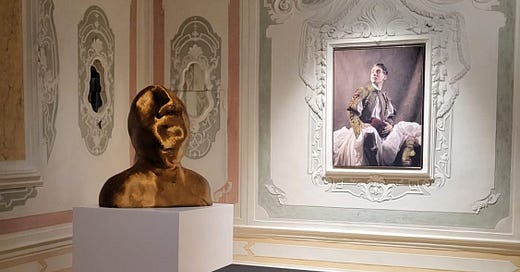When I tell you that I GASPED
Let me tell you about my visit to Foundation Valmont: They did not come to play. Some exhibitions like to get way too philosophical. And I mean waaaaaaaaay too philosophical. But EGO? Perfect.
EGO - Fondation Valmont
What is the Ego? Sure, you can write dissertations, books, and conference papers, ask your therapist (when was the last time you went to your therapist? They miss you). The exhibition at Fondation Valmont was actually able to break it down into three simple yet thoughtful definitions by three artists.
For Carles Valverde, the ego is “uniqueness” and “individuality”, something you can’t repeat or copy. Together, these many egos form society, like building blocks (or Lego, but I didn’t say that. You did). For the show, he created black foam sculptures. Every single one of them is unique, but together, they can form something new, something greater than them.
Didier Guillon looks at ego not as an individual in a group, but rather as what makes an artist. To him, art is the creation of beautiful things, the artist is the one who creates these beautiful things, and the ego is the artist’s awareness of being a creator of beautiful things. But what if an artist created something that was not obviously beautiful (medium-ugly like Pete Davidson if you will)? Would that still be art? Would they still be an artist?
Guillon 3D printed bronze-like busts - busts of powerful people are a classic in art. But to spice things up, he mashed up the faces, making them unknown people, not even real human beings at this point. I like the way that they look like ancient Cycladic figurines from Greek islands, which brings me to the next artists.

I know I said it’s three definitions by three artists, but the last two collaborate together so that makes them one. Therefore, the math is still mathing. Together, Vangelis Kyris and Anatoli Georgiev see ego as what makes us human. Ego is responsible for creating complex culture and heritage, but also pride and selfishness. The ego is part of us. Kyris is interested in how the photographer puts themselves into a powerful Godlike position when creating an image. He photographed people dressed in centuries-old Greek and Adriatic costumes. There is pride in the heritage, in the beauty.

Georgiev goes on to embroider the photographed costumes, skillfully highlighting the texture of the fabrics. To him, the ego is in all our senses, it is part of our awareness. With embroidery, he makes us aware of light, our desire to touch the fabrics, to move around the glistening texture. Look at this detail: Isn’t it amazing how Georgiev embroiders only the part that catches the light?

As a side note, the contrast of light and dark is giving very much Caravaggio, an Italian painter from the 17th century who basically invented the use of extreme contrast in painting (and he was known to have some serious ego issues too, but I digress…).
If you’d like to get a look at the exhibition, here’s a youtube video produced by Fondation Valmont. If you happen to be in Venice, you can see EGO at Fondation Valmont inside Palazzo Bonvicini until February 25, 2024.
Fondation Valmont
Palazzo Bonvicini
Calle Agnello, 2161/A
30135 Venezia VE, Italy
Open every day from 10 am to 6 pm
Free entry
info@fondationvalmont.com
If you enjoyed my review, feel free to subscribe to my substack. And if you know someone who would have fun with my content, I’d appreciate your referral, thank youuuuuuuu!
See you soon!
Jennifer






